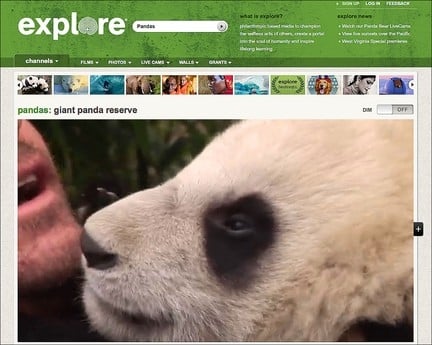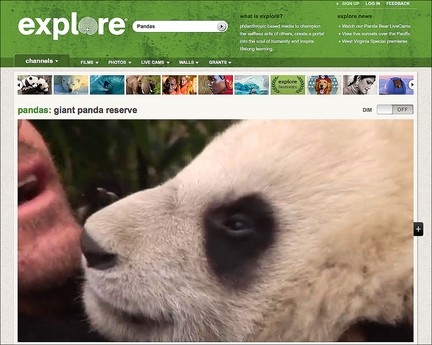
OCEAN AVE — Between 5 p.m. and 4 a.m., anyone can take a mental trip to China to watch one of four giant pandas munch on bamboo or tussle with its siblings from its home in the Ya’an Panda Base, part of the China Conservation and Research Center for the Giant Panda.
For most, the pandas live in the imagination, made accessible only through nature documentaries, photographs or the occasional over-priced stuffed animal from a trip to the San Diego Zoo.
Santa Monica-based explore.org changed that when two web cams went live last month streaming footage of four toddler bears from the remote study center for the first time.
The “Panda Cams” join others based in Long Beach, Vancouver and Santa Monica as part of the “Pearls of the Earth” initiative begun by explore.org founder Charles Weingarten to expose people to the beauty and magnificence of the natural world which they might otherwise not have the opportunity to experience.
Through the cameras, viewers can watch animals play or relax to the view of a fantastic Santa Monica sunset over the open ocean as seen from the roof of the Shangri-La Hotel.
“I want people to fall in love with the world again by observing it,” said Weingarten, a filmmaker and philanthropist who’s spent years capturing the stories of inspirational people from far flung India to the Mississippi Delta.
Unlike the edited shorts that populate the site, the webcams provide a personal portal into the lives of the creatures that drift in front of the lens, be they the young pandas at the preserve or the polar bears broadcast as they migrated in November.
Weingarten hopes that people will tune into the channels broadcast through his site, fall in love with the stars of the world’s least-produced reality show and feel inspired to live with the well-being of the animals, and the planet, in mind.
The polar bears, for instance, can only travel north within their icy world to food sources when the ice becomes thick enough to support their massive weight. That ice is freezing later and later in the year.
“I hope people will follow the polar bear every day,” Weingarten said. “Did the ice freeze today? Did my friend eat today?”
Never a mention of the controversial topic of global warming, or an admonishment for the amount of fossil fuel your car burns.
“See? I didn’t scare you once,” Weingarten said.
Operating webcams in remote locations comes with its own set of challenges, the first of which is forging the relationships that allow you to put the cameras up in the first place.
It was a rare honor to get cameras in the research center, one that Weingarten calls “panda diplomacy” after Richard Nixon’s famous “ping pong diplomacy” of the 1970s.
“We’ve developed friendships,” he said. “It shows there are good people anywhere doing good work.”
The technology that makes Weingarten’s work possible has limitations.
Dealing with a webcam that freezes in the tundra or mists during rain is difficult, and then comes solving problems inherent with transmitting data between countries and supporting the viewership of thousands.
It’s worth it to provide the seeds of inspiration, Weingarten said.
“It’s so exhausting to hear about things that are coming to an end. We need to try a new story based on love and compassion,” he said.
Weingarten and his team seek to tell that story through people as well as webcams.
They travel to far flung areas of the world as well as deeply isolated pieces of America to practice a hands-on kind of philanthropy, meeting the individuals involved in a cause before giving them the monetary help they need through Annenberg Foundation grants.
If explore.org’s stats reveal anything, it’s that the story is popular and people are using the Internet and television to access it.
According to the organization’s 2009 tax documents, explore.org produced 280 video segments. Those reached 7,400 people through theatrical screenings, and 731,327 through the Internet. Another 18.4 million tuned in on their televisions and nearly 3 million on RSS feeds.
The total: 22,240,745 touched by explore.org’s work in that one year for a budget of roughly $4 million.
People can watch the videos and explore the causes explore.org supports from the website.
If it’s just the beauty of the world you seek, however, wait ‘til late in the day and catch the sunset.
ashley@www.smdp.com









